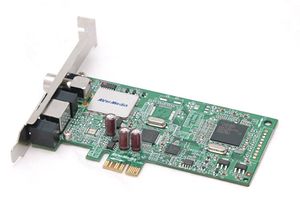AVerMedia AVerTV Hybrid Speedy PCI-E: Difference between revisions
Jump to navigation
Jump to search
(Convert lede to prose. Fix capitalization.) |
(Copy edit driver text. Add the takeaway point (that it's unsupported) to the lede.) |
||
| (5 intermediate revisions by the same user not shown) | |||
| Line 1: | Line 1: | ||
[[File:Aver-speedy-pcie-2.jpg|thumb|An AVerMedia AVerTV |
[[File:Aver-speedy-pcie-2.jpg|thumb|An AVerMedia AVerTV Hybrid Speedy PCI-E]] |
||
{{ArticleNeedsExpanding}} |
{{ArticleNeedsExpanding}} |
||
The '''AVerMedia AVerTV |
The '''AVerMedia AVerTV Hybrid Speedy PCI-E''' ('''H788R''') is a [[PCIe]] analog and [[DVB-T PCIe Cards|DVB-T]] device from [[AVerMedia]]. It is currently unsupported under Linux. |
||
==Overview/features== |
==Overview/features== |
||
| Line 14: | Line 14: | ||
===Images=== |
===Images=== |
||
<gallery |
<gallery> |
||
File:Aver-speedy-pcie-TDA18271HDC1.jpg|TDA18271HDC1 |
File:Aver-speedy-pcie-TDA18271HDC1.jpg|TDA18271HDC1 |
||
File:Aver-speedy-pcie-WJCE6353.jpg|Intel WJCE6353 |
File:Aver-speedy-pcie-WJCE6353.jpg|Intel WJCE6353 |
||
| Line 54: | Line 54: | ||
===Drivers=== |
===Drivers=== |
||
Drivers for the bridge interface (saa716x) |
Drivers for the bridge interface (saa716x) can be found [http://jusst.de/hg/saa716x/ here]. Once installed, the card will be recognized as a DVB device. However, with there being no glue code for the device's [[frontend]], it remains unsupported. |
||
===Sample kernel output=== |
===Sample kernel output=== |
||
| Line 62: | Line 62: | ||
SAA716x Hybrid 0000:03:00.0: setting latency timer to 64 |
SAA716x Hybrid 0000:03:00.0: setting latency timer to 64 |
||
DVB: registering new adapter (SAA716x dvb adapter) |
DVB: registering new adapter (SAA716x dvb adapter) |
||
===Remote control support=== |
|||
==External links== |
|||
* http://www.avermedia.com/avertv/Product/ProductDetail.aspx?Id=425 |
|||
Latest revision as of 00:46, 24 December 2016
| This article is a stub or is incomplete. |
| This article requires expansion. Please help add informative information if you can. |
The AVerMedia AVerTV Hybrid Speedy PCI-E (H788R) is a PCIe analog and DVB-T device from AVerMedia. It is currently unsupported under Linux.
Overview/features
Components used
- TDA18271HDC1
- Intel WJCE6353
- NXP SAA7136E/1/G
- PCI-E bridge NXP SAA7160ET
Images
Identification
#lspci
03:00.0 0480: 1131:7160 (rev 03)
Subsystem: 1461:1455
Control: I/O+ Mem+ BusMaster+ SpecCycle- MemWINV- VGASnoop- ParErr- Stepping- SERR- FastB2B- DisINTx-
Status: Cap+ 66MHz- UDF- FastB2B- ParErr- DEVSEL=fast >TAbort+ <TAbort- <MAbort- >SERR- <PERR- INTx-
Latency: 0, Cache Line Size: 32 bytes
Interrupt: pin A routed to IRQ 17
Region 0: Memory at ea100000 (64-bit, non-prefetchable) [size=1M]
Capabilities: [40] Message Signalled Interrupts: Mask- 64bit+ Count=1/32 Enable-
Address: 0000000000000000 Data: 0000
Capabilities: [50] Express (v1) Endpoint, MSI 00
DevCap: MaxPayload 128 bytes, PhantFunc 0, Latency L0s <256ns, L1 <1us
ExtTag- AttnBtn- AttnInd- PwrInd- RBE- FLReset-
DevCtl: Report errors: Correctable- Non-Fatal- Fatal- Unsupported-
RlxdOrd+ ExtTag- PhantFunc- AuxPwr- NoSnoop-
MaxPayload 128 bytes, MaxReadReq 128 bytes
DevSta: CorrErr- UncorrErr+ FatalErr- UnsuppReq- AuxPwr- TransPend-
LnkCap: Port #1, Speed 2.5GT/s, Width x1, ASPM L0s L1, Latency L0 <4us, L1 <64us
ClockPM- Suprise- LLActRep- BwNot-
LnkCtl: ASPM Disabled; RCB 128 bytes Disabled- Retrain- CommClk-
ExtSynch- ClockPM- AutWidDis- BWInt- AutBWInt-
LnkSta: Speed 2.5GT/s, Width x1, TrErr- Train- SlotClk- DLActive- BWMgmt- ABWMgmt-
Capabilities: [74] Power Management version 2
Flags: PMEClk- DSI- D1+ D2+ AuxCurrent=0mA PME(D0+,D1+,D2+,D3hot-,D3cold-)
Status: D0 PME-Enable- DSel=0 DScale=0 PME-
Capabilities: [80] Vendor Specific Information <?>
Capabilities: [100] Vendor Specific Information <?>
Kernel driver in use: SAA716x Hybrid
Kernel modules: saa716x_hybrid
Making it work
Drivers
Drivers for the bridge interface (saa716x) can be found here. Once installed, the card will be recognized as a DVB device. However, with there being no glue code for the device's frontend, it remains unsupported.
Sample kernel output
#dmesg SAA716x Hybrid 0000:03:00.0: PCI INT A disabled SAA716x Hybrid 0000:03:00.0: PCI INT A -> GSI 17 (level, low) -> IRQ 17 SAA716x Hybrid 0000:03:00.0: setting latency timer to 64 DVB: registering new adapter (SAA716x dvb adapter)



